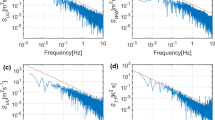Summary
¶Simultaneous flight measurements with the research aircraft Do 128 and the helicopter-borne turbulence probe Helipod were performed on 18 June 1998 during the LITFASS-98 field experiment. The area-averaged turbulent vertical fluxes of momentum, sensible, and latent heat were determined on a 15 km × 15 km and a 10 km × 10 km flight pattern, respectively. The flights were carried out over heterogeneous terrain at different altitudes within a moderately convective boundary layer with Cumulus clouds.
Co-spectra-analysis demonstrated that the small scale turbulent transport was completely sampled, while the comparatively small flight patterns were possibly of critical size regarding the large-scale turbulence. The phygoide of the airplane was identified as a significant peak in some co-spectra. The turbulent fluxes of momentum and sensible heat at 80 m above the ground showed systematic dependence on the location of the flight legs above the heterogeneous terrain. This was not observed for the latent heat flux, probably due to the vertical distribution of humidity in the boundary layer.
Statistical error analysis of the fluxes F showed that the systematic statistical error ΔF was one order of magnitude smaller than the standard deviation σ F . The difference between area-averaged fluxes derived from simultaneous Helipod and Do 128 measurements was much smaller than σ F , indicating that the systematic statistical error was possibly over-estimated by the usual method.
In the upper half of the boundary layer the airborne-measured sensible heat flux agreed well with windprofiler/RASS data. A linear fit was the best approximation for the height dependence of all three fluxes. The linear extrapolations of the latent and sensible heat fluxes to the ground were in good agreement with tower, scintillometer, and averaged ground-station measurements on various surface types. Systematic discrepancies between airborne and ground-based measurements were not found.
Similar content being viewed by others
Author information
Authors and Affiliations
Additional information
Received June 18, 2001; revised December 21, 2001; accepted June 3, 2002
Rights and permissions
About this article
Cite this article
Bange, J., Beyrich, F. & Engelbart, D. Airborne measurements of turbulent fluxes during LITFASS-98: Comparison with ground measurements and remote sensing in a case study. Theor. Appl. Climatol. 73, 35–51 (2002). https://doi.org/10.1007/s00704-002-0692-6
Issue Date:
DOI: https://doi.org/10.1007/s00704-002-0692-6




